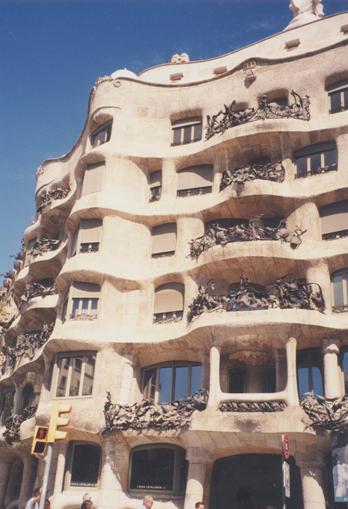In the last five years, tapas has taken off in Cape Town. From a couple of short-lived dedicated restaurants, I now count ten that specialize in tapas, several of them wine bars, such as the very popular Cafe Caveau. Woolworths has introduced the concept in some of their stores. There are dozens more offering ‘tapas’ in addition to or instead of what used to be called starters. And now there is a chain, Cafe Sofia, with already six branches in Cape Town. They have a huge menu, but well beyond the competency of their kitchens.
I tried the Kloof Street Cafe Sofia several times. The tapas was a bland assortment of wholesale ingredients offered at speciality prices, hardly worthy of the appellation: rubbery, thawed out mussels in broken shells; tepid sauces; squid tubes stuffed full of watery rice (with neither spicy shrimp nor chorizo as promised on the menu). Skip their monster versions of ‘tapas’; they are better at big plates of meat.
Tapas is now widely used to mean small plates of food. You get everything from African to Asian ‘tapas’. Originally, it is of course Spanish, perhaps, with a Levantine meze influence.
Tapa means ‘lid’, and comes from the habit of placing a slice of bread over a glass of evening tipple to keep the muggies out. The bread slice was slowly supplanted by saucers with titbits on top. Under King Alfonso X (1221-1284), bars became legally obliged to serve alcohol only with food. From evening nibbles, tapas blossomed into a range of delicious hors d’oeuvres, becoming a cuisine which now substitutes for a three-course meal.
For those uninitiated and who find themselves in Barcelona, I can recommend a popular, lively joint right on the shopping avenue of Passeig de Gràcia. Touristy Tapa Tapa hasn’t the best tapas, but the friendly waiters speak English, the menu is vast, the prices around €2 each. Take a bar stool and order. There is a constant turnover, making it a great place not only to become acquainted with tapas, but to meet cosmopolitan strangers.
In the course of one scintillating evening, between my tomato tartlet, boquerones (anchovies), patatas bravas, deep-fried baby spuds with piquant tomato sauce, Fuet sausage, Iberian ham, white sausage, ratatouille with shrimps, I chatted to two gorgeous Japanese girls who polished off two pints of beer, a bottle of red and a bottle of Freixnet; a married, bourgeois Austrian couple who proposed a threesome; an American industrialist who had made millions putting the stripes in toothpaste; and three boys from Brazil. Something about adventurously sampling a variety of scrumptious morsels apparently loosens people up.
It’s the type of cuisine that suits the unstructured, all-hours vibe of Long Street particularly well, and several tapas establishments are to be found here.
In 2006, Fork replaced the eccentric Italian restaurant Osteria antico dolo. They’ve kept the church pew bench downstairs and put in banquettes upstairs. On two floors and with a roof terrace, it offers several convivial options.
The tapas is not traditional, but eclectic, using ingredients from South Africa (such as ostrich and kudu), Asia (tatsoi and wasabi) and even Moroccan meatballs. All the dishes I tried were tasty: from simple roast broccoli (R25) to pork rillettes served with pickles and crostini (R35); chicory leaves topped with olives, walnuts and gorgonzola dressing (R40); artichoke and pecorino salad with balsamic dressing (R45); marinated lamb cutlets with a creamy, spring onion and cumin sauce (R55).
Further up Long, on the same side of the street, is the newly-opened Ultima Tapa. It too has exposed brickwork, dim lighting, and soft music. A large, rather grey, flimsily executed copy of Salvador Dali’s blond Christ at the sacrament of the Last Supper adorns the main wall; a television has a looped slide show of Gaudi’s buildings and Spanish art. Alongside the attractive black mosaic tiled bar is a large sash window allowing one to see into the kitchen.
Still in its early days, the menu is a photocopy, and the tab is written by hand and added up manually by the waiter.
Aiming at more authentic fare they have a range of classic tapas servings. A couple of square bites of tortilla de patatas (a potato and egg filled omelette) are offered complimentary to start.
Their most successful tapas: huge, creamy Knysna oysters grilled in their shells; ceviche tres mares – fish and prawn marinated in lemon with finely chopped red onion; crisped white bait with a light mayonnaise; brown and white anchovies with pimento, large capers and olives; moist roast quail legs. Not everyone will respond to the morcilla (blood sausage) and sweet breads.
The paella and the rice with squid ink are satisfactory, but still need work. Their garbanzo beans (chickpeas) also needed some natural enhancement.
The least successful: pulpo (octopus tentacle), which was far too fibrous (everyone has their trick for tender octopus, but you always need to watch it like a hawk, as it goes from tender back to tough); the rabbit leg too (served with fava beans) was very rubbery (this bunny didn’t hop so much as bounce). Grilling rabbit is tricky, the secret I’m told is to slow cook and either overdo the basting or wrap it in foil.
The jamón serrano (smoked Spanish ham) is authentic, but instead of being left to dry on a slice of baguette, it could have been paired with a little melon or some imagination.
To finish, you can’t go wrong with a few slices of quezo mandego mahon, Spanish cheese. I can also recommend the delicious saffron ice-cream.
Cafe Sofia, 60 Kloof Street, Cape Town. Tel: 021 426 0801.
Caveau Wine Bar, Heritage Sq, 92 Bree Street, Cape Town. Tel: 021 422 1367.
Fork, 84 Long Street, Cape Town. Tel: 021 424 6334.
Tapa Tapa, Passeig de Gràcia 44, Barcelona, Spain. Tel: 093 488 3369.
Ultima Tapa, No 224B Long Street, Cape Town. Tel: 021 422 2003.
This article appeared in the Mail & Guardian, 30 July 2010.

